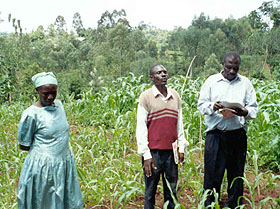 |
||||||||||||||||||||||||||||||
Kenya
Edzawa Catchment of the Yala River Site coordination is by Kenya Agricultural Research Institute (KARI) in Kakamega. Research team members are from KARI Kibos, KARI Kakamega, KEFRI, TSBF and district extension. There have been links with various NGOs such as CARE, OMNI and some other small NGOs who have moved in and out of the district, with the Legume testing network, and various soils and crops regional networks (AFNETA, ECABREN and AFRENA). ICRAF, TSBF and CIAT scientists have also been involved. The Vihiga area is the most populated of the AHI benchmark sites (1,200 people/sq km). The topography is plateau-like with small valley bottoms and slight to moderate slopes. The area drains into the Edzawa River, a tributary of the Yala which in turn drains into Lake Victoria. The KARI team is working where there is a limited cash economy and poor links to markets, an area that is a net importer of food (production meets only 3 months demand a year), and very small land holdings. Sources of off-farm income are necessary to survive. The major soil fertility limiting factor is phosphorus (P), and this leads to poor yields and pest and disease problems (striga, bean root rot, and others). P deficiency is indicative of large areas of highlands in Africa. Livestock feed legumes are being grown in small niches in order to improve livestock feed, improve soil fertility and manure quality. This effort is linked to manure management. Because of extremely small farm sizes, a number of pests and diseases have arisen due to lack of rotation and declining soil fertility: striga in maize and bean root rots. The level of intensification is very high and where many other systems are headed in the future. The first aim has to improve soil fertility in all land use areas including addressing the phosphorus limitation. Returns to investment of P application are high, but farmers still seem reluctant to do this—they would rather invest in other livelihood options. A number of options are being tested with a relatively large number of farmers: combinations of inorganic and organic (for those having a limited supply of nutrients); intercropped legumes (feed, food and soil improving); relayed shrubs and herbaceous legumes; biomass transfer of tithonia, and short term improved fallow, various species on bund edges. Technologies only advance if farmers provide a favourable evaluation. The results are now ready to scale up and this will be one focus of research. Other issues include: marketing and credit; finding ways to increase income particularly of female headed households; water shortages and river management. Farmer research groups were formed in 1999. These are now linked between villages and among technology testing and community seed production groups. Several farmer field schools are run by the farmers groups and have developed their own curriculum and research is assisting in providing technical knowledge into FFS trials and in linking them to other expertise that is requested. A policy task force has been formed which is looking at key policy issues from the local perspective, such as lack of credit that has an impact on uptake of technologies. |
||||||||||||||||||||||||||||||
